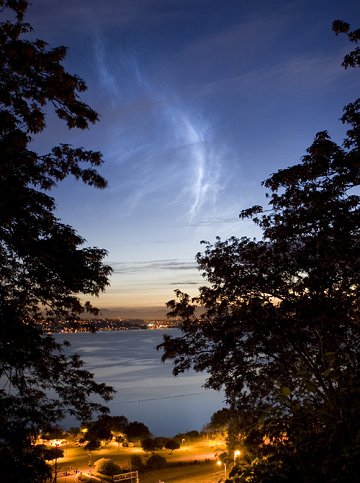 Where's Saturn? Is that a UFO--or the ISS? What's the name of that star? Get the answers from mySKY--a fun new astronomy helper from Meade. Where's Saturn? Is that a UFO--or the ISS? What's the name of that star? Get the answers from mySKY--a fun new astronomy helper from Meade. TILTED PLANET: On June 21st at precisely 18:06 UT (2:06 pm EDT), Earth's north pole will be tipped to the max (23.5o) toward the Sun. This marks the beginning of summer in the northern hemisphere, and winter in the southern hemisphere. The seasons are changing--Happy Solstice! NLCs INVADE THE USA: On June 19th, bright noctilucent clouds (NLCs) descended over the lower United States. "This is the first time I've seen NLCs in this area for many years," says Kellen Harrel of Portland, Oregon. "The clouds were glowing very brightly." One state away, Jonathan Berry snapped this picture overlooking Lake Washington: 
Photo details: Canon 20D, 24mm, f/2.8, ISO 100, 8 sec
Noctilucent clouds are a mystery. They were first reported in the 19th century after the eruption of supervolcano Krakatoa. In those days the clouds were confined to high latitudes, but they have intensified and spread with sightings in recent years as far south as Colorado and Utah. What causes NLCs? A NASA spacecraft named AIM is orbiting Earth on a mission to find out. Summer is the season for NLCs, so keep an eye on the western sky after sunset. If you see electric-blue tendrils spreading up from the horizon, you've probably spotted a noctilucent cloud. June 2007 Noctilucent Photo Gallery
["Noctilucent Cloud"--the song] [Night-Sky Cameras] DOUBLE FLYBYS: Space shuttle Atlantis returns to Earth today (ground tracks) bringing to an end the double flybys that have delighted sky watchers across the USA this week. Last night photographer Darrell Spangler caught the ISS and Atlantis flying in tandem over Drake, Colorado: 
Photo details: Canon EOS 300D, 30sec, f/5.6, 1600ISO
With Atlantis back on Earth, the International Space Station will appear solo in the nights ahead--and it is brighter than ever with the addition of two new sprawling solar arrays. When should you look? There are two ways to find out: Sign up for flyby alerts from Spaceweather PHONE or check the flyby time tables at Heavens Above. more images: from Jimmy Westlake of Stagecoach, Colorado; from Michael Gavan of Kalamazoo, Michigan; from Tony Wilder of Chippewa Falls, Wisconsin; from Jun Lao of Mason, Ohio; from Edmund Kasaitis of Manchester, Maryland; from Michael Borman of Evansville, Indiana; from Simian Etienne of Saint Martin de Crau, southern France; | 
